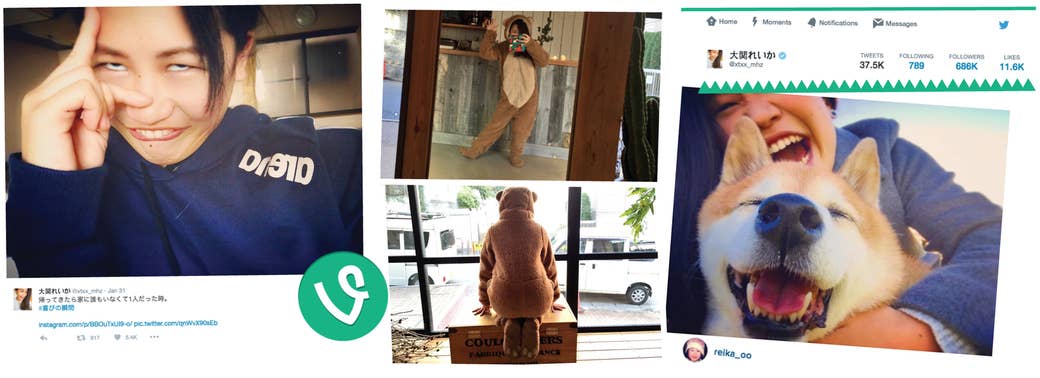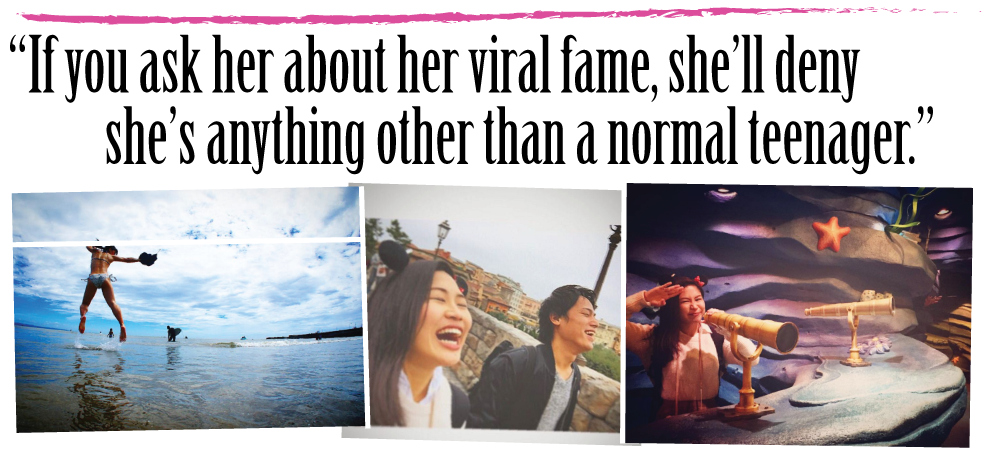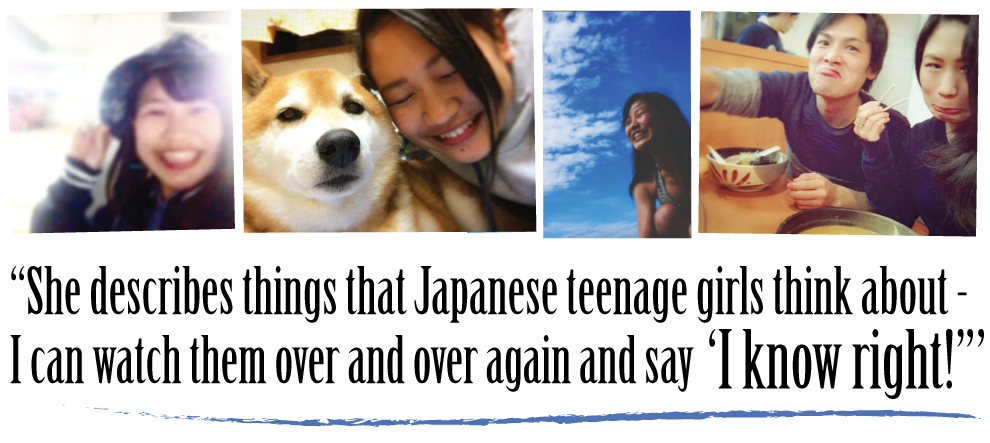
TOKYO — Reika Oozeki has a cold. But as she sits in her agency's office in jeans and a hoodie, drinking a cup of tea, it's clear that — cold or no cold — Reika IRL is not the hyperactive teenager she plays six seconds at a time on the internet. It is hard to believe that this is the same 19-year-old who, currently at 673,000 followers and 676,000,000 loops, has the most followed Vine account in Japan.
For one thing, she isn’t riding around on a hoverboard.
Oozeki’s Vines are usually delightfully mundane. She’s made a lot of videos about how girls act around their boyfriends versus how they act with their friends. She’s done videos parodying the movie Frozen. Last year, she made a video of her just making popping noises with her mouth. It has 5 million loops. When she tells jokes, she usually screams while contorting her face. Imagine Jim Carrey channeled through a 19-year-old Japanese girl with a smartphone.
If you ask Oozeki about her viral fame, she’ll deny she’s anything other than a normal teenager who happens to make six-second videos with her phone. But Oozeki and girls like her are using Vine in particular to quietly carve out a new space for young female performers who want to bypass Japan’s incredibly strict and hierarchical entertainment industry. By just doing her thing, she’s slowly subverting the typical way young women in Japan achieve stardom — and other girls are noticing.

Oozeki’s first big viral hit was a Vine in 2013 about how couples act at Disneyland. The Vine is called “Going to Disneyland" and it starts with Oozeki addressing the camera, selfie-style. “When going to Disneyland with your boyfriend: 'This is so fun! Let’s take our time!’” Then there’s a cut and Oozeki says, “When going to Disneyland with your friend: ‘Let’s go! Let’s go! Run! Run! Run! They’re going to run out of Fastpasses!’” The Vine has over 8 million loops.
She already had a decent following on Twitter, but when she posted the "Disneyland" video, her account went nuts. “I thought, if there are so many people who will laugh at me doing such a silly thing, and since I’ve always liked getting a laugh out of people, simply put, I was happy. I wanted to do more Vines and get more laughs,” she said.
Almost three years after the "Disneyland" Vine, it’s safe to call Oozeki "internet famous", though she’s still on the lower end of the fame scale. YouTube is the biggest online video platform in Japan. Hikakin is Japan’s biggest YouTuber, with 2.8 million subscribers. He has 1.44 million followers on Twitter. Actual Japanese celebrities — for instance, someone like pop star and model Kyary Pamyu Pamyu — typically have millions of followers on Twitter.
On Vine, Oozeki’s numbers are smaller than her American contemporaries, like L.A.-based Vine star Logan Paul, who has 9 million followers and almost 4 billion loops. But in Japan, Oozeki is leading the pack. Brian Jesse, a half-Japanese, half-American comedian and impersonator, is a close second. Jesse is the only Vine star to crack a billion loops and has more followers on Twitter, but his following elsewhere doesn’t appear to be nearly as rabid. Oozeki’s reach is spread all over social media, as well. She has a huge Instagram following, there are Facebook fan pages for her, and compilations of her Vines regularly pull in over a million views on YouTube. Her work is even subtitled in English by her fans.
All of this is to say that both the internet and fame operate differently in Japan than they do in the West. Taken together, Vine and Twitter’s native video would be the third-most popular video platform, behind YouTube and a Japanese livestreaming platform called Nico Nico Douga. Almost half of all social media users in Japan use Twitter. It’s bigger in Japan than Facebook. According to Alexa data, 10% of all visits to the vine.co domain come from Japan — second only to the U.S.
In Japanese, Twitter’s 140-character limit allows you to write whole paragraphs of information and retweets are incredibly popular. It’s common to come across tweets with 20,000 or 30,000 retweets. Japanese Twitter users prefer anonymity; it is rare to see someone use their real name as their username and it’s even rarer to find someone who is using their own face as their avatar. Japan’s attitude towards exhibitionism might be best summed up by the Japanese saying “deru kugi wa utareru” or “The nail that sticks out gets hammered.” And that cultural expectation of conformity is even stricter for women, especially for teenage girls like Oozeki.

Beyond the cultural hurdles, Japan’s mainstream pop star industry, spread across print, TV, movies, and radio, is regularly accused of child abuse, sexual exploitation, and being a direct pipeline to the Yakuza — Japan’s incredibly sophisticated organized crime groups.
The typical process for a young woman in Japan trying to get into the entertainment industry is to first become an "idol." You typically become an idol by starting either as a hostess at a cabaret club or as a guradoru — a magazine idol, or pinup girl. Then if you’re pretty and talented enough you get picked up by an agency and put into a grueling gasshukujo — or pop-star bootcamp — with dozens of other girls. After all of that you get assigned an idol group and a sub-team within that idol group. The biggest idol group in Japan right now is AKB48, which has 127 members divvied up over five different teams. Every year, many of Japan’s top idol groups then have elections for their main girls. Because being an idol means being an object of fantasy for male fans, most girls sign contracts promising not to have any romantic relationships. Oh, and after all of that, your agency will usually take a cut of about 60% of your earnings. But if you end up a main girl in an idol group, you get TV spots, acting roles, and modeling contracts.
Oozeki’s path into minor stardom has been much less structured. After Oozeki’s "Disneyland" video, she decided to make more Vines. When asked about the decision to post them under her own name and show her face, she said she was worried about what her family would think.
“I worried that my mother and other family might tell me that was bad, but actually, they didn’t act like it was bad at all,” said Oozeki. “They said it’s fine if that’s how I get everyone to know my face. They didn’t mind at all.”
Oozeki's success caught the eye of GROVE, a company that works with young Japanese social media stars to turn their social media presence into a source of income. In exchange for a portion of her income, GROVE gives her resources, technical support, and artist management services, as well as set her up with brands to make videos with. Oozeki said she still only shoots the videos she wants to make.
“I shoot videos that I find fun, not because I feel like I have to,” she said. “But because I just have fun doing it, when I want to shoot something, I do. If I don’t feel like it, I don’t. Since I only shoot when I want, I don’t get that feeling of getting tired of it at all.”

In the West, there are regular Vine meet-ups, parties, and conventions for stars to interact with their fans. In Japan, the meet-ups are mainly for the Viners to meet with potential advertisers.
It was at one of these networking events that Oozeki met her current boyfriend and fellow Viner Hokuto Ikura, who goes by Hokupi, and also works with GROVE.
“That night we went to get ramen and I was super interested in him,” she said. “He’s funny, you know, kind of like that. From there, we kept talking more and more until eventually we started dating.” Oozeki said the fan reaction was minimal.
“On the one hand, people were saying things like, ‘Reika-chan has a boyfriend, she seems so happy, I’m glad for her,’ but on the other, people were making Vines that dissed my offline life. But even as they made fun of me, this was my real life, you know? So I still felt like I was on the winning side,” she said, laughing.
When asked if she thinks the freedom to date is one of the charms of using such an open platform like Vine — GROVE never made her sign some kind of idol “no relationships” contract — Oozeki simply replied, “I’m not a celebrity, so it’s not a big deal.”
That attitude is a really good example of the odd place in Japanese culture where Oozeki exists. When huge Vine stars date in the U.S., fans typically have a lot of opinions over who their favorite stars should and shouldn’t date. The most famously disastrous example of this was the collaborative relationship between Curtis Lepore and Jessi Smiles, which ended in Lepore taking a plea deal after being charged with allegedly sexually assaulting Smiles.
And then there’s how celebrity “relationships" work for entertainers in Japan. In January, the Japanese entertainment world was rocked by a sex scandal involving the half-Japanese, half-English singer and TV personality Becky. Messages were leaked to weekly magazine Shukan Bunshun, revealing that Becky was having a secret affair with Kawatani Enon, a guitar player in two different J-rock bands. The messages also revealed that Enon was secretly married. Very little happened to Enon — he cried onstage giving a public apology. Meanwhile, Becky is said to be leaving the entertainment industry, her career effectively over.

Luckily for Oozeki, the Japanese definition of celebrity may not extend into the world of Vine just yet. She gets recognized on the street, especially in hip young areas of Tokyo like Harajuku. She gets approached by teenagers all the time. She takes selfies with them. She said it doesn’t usually get too weird, but sometimes teenage boys will start to follow her around. When that happens she likes to spin around and freak them out by saying "Hi" first.
This quiet sort of celebrity is working for her. GROVE has helped Oozeki get on TV and written up in newspapers, and has given her resources to shoot more complex Vines. Last September, she scored a role in a Japanese coming-of-age movie called Watashitachi No Haa Haa or Luv Ya Hun!, which follows Oozeki and three other high school girls on a bicycle trip to Tokyo.
“Since I’m used to making six-second videos, anything longer than that seems so much longer to me,” she said of filming her first full-length acting role. “But it’s not like I was really emotionally or mentally exhausted or anything.”
Japanese society may not be watching Oozeki’s quiet rise to fame, but other girls her age are. Her influence is pretty noticeable on Japanese Vine. Her spontaneous, quirky, selfie-based videos are a Japanese Vine style all of their own. She thinks that’s pretty cool. Girls even send her videos sometimes. She never thinks of it like she’s being ripped off.
“I think there are a lot more people who create videos now because of me,” she said. “My Vines are me, and those people, even if they copy me, those videos are theirs. I don’t really think of it as something that was stolen.”
Japanese Viner, Hira "H!RA" Park, noticed Oozeki’s influence on Vine, especially when it comes to other young girls. “Because of her, a lot of girls in Japan have changed. I mean that girls are becoming better about putting their own faces in pictures, movies, and on social networking sites like Vine and Instagram," Park said.
One of those girls directly influenced by Oozeki is Alice Morisaki, a YouTuber and Viner who saw Oozeki making Vines and decided she wanted to do the same thing. At first, Morisaki was uploading makeup tutorials to YouTube. But when she saw Oozeki doing natural and relatable videos on Vine, she switched directions entirely. Now, Morisaki makes videos that she describes as “uploading the normal me."
“[Oozeki’s] Vine videos are short and have stories, so I feel comfortable watching them. She describes things that Japanese teenage girls think about — I can watch them over and over again and say, ‘I know, right?’ to many things she says,” Morisaki said. “She has had a huge influence on me, and I think there are a lot of girls who are cheered up by her.”
Ultimately, Oozeki still doesn’t really feel like Vine is something she wants to put all of her energy into just yet. She knows she loves music and performing. She briefly considered joining a theater troupe, but worried it was too strict. School is her main focus at the moment — her teachers are big fans of her videos, she said. As for her video career, Oozeki is content with just seeing what happens.
“All you need to make a video is to press the home key on your phone and then let go," she said with a shrug. "You can record videos casually, as well as watch them casually. You could even watch them on the train. If you want to focus on recording, you can make videos about everyday things, that’s what I did at first."
Check out this week's episode of the BuzzFeed's Internet Explorer podcast if you want to hear more about Reika Oozeki and the world of Japanese Vine!
This article contains additional reporting from Keijiro Abe and Eimi Yamamitsu.

